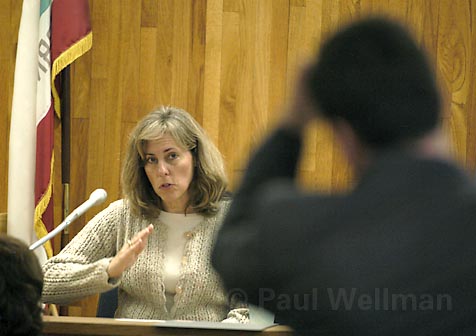
The California Court of Appeals rejected arguments that Santa Barbara prosecutor Josh Lynn engaged in prosecutorial misconduct during the vehicular homicide trial of Montecito real estate agent Maureen McDermut, who accidentally killed pedestrian Joseph Cohn while he was taking a nighttime stroll along Hot Springs Road in August 2003.
Likewise, the court found that Judge George Eskin did not err in admitting a simulated photograph prepared by the prosecution to show what the victim may briefly have looked like on the hood of McDermut’s car, as well as video showing the route McDermut may have taken prior to hitting Cohn, who was holding hands with his wife as he was struck.
McDermut was sentenced to one year in jail and had served five months when Eskin cut her loose. Since then, she has faithfully observed all the terms and conditions of her probation.
McDermut’s attorney Robert Sanger argued that the simulated photograph should never have been admitted because it was prejudicial against McDermut and at odds with the actual facts in several key details. The point of the photo was to impeach McDermut’s claim that she did not know that she had struck a pedestrian.
During the trial, she claimed she thought she might have hit a coyote and called the authorities the next day to enquire whether there’s been any accidents the night before. The simulated photo showed an investigator with the District Attorneys office spread on his back across the front right portion of the Explorer’s hood, his head over some bolts protruding from the hood and his feet draped over the headlights. The prosecution had argued it would have been next to impossible for McDermut not to have seen that she struck someone and used the photo to buttress that argument.
Sanger countered that because the investigator was much larger than the victim, that the photo was taken during daylight hours-and not at night when the accident occurred-it provided a false impression.
Furthermore, Sanger contended that photograph was taken by pointing the camera to the passenger’s side of the vehicle and not straight ahead, where a conscientious driver presumably should be looking. In any case, Sanger claimed, the victim would have been in that posture for less than one-tenth of second, and would have been easy to miss. Two of the appellate judges argued that because the jury was informed of these differences during the trial, there was no miscarriage of justice. A third justice argued the photograph should not have been admitted, but concluded its inclusion was not enough to taint the verdict.
Similar arguments were raised regarding the videotape made by investigators-which clearly showed the white lines of the bike path in which the victim was walking-with identical results.
Sanger argued that the prosecutor Lynn had crossed the line during closing arguments by dimming the courtroom lights as a dramatic device to illustrate his contention that McDermut had to have seen the damage inflicted on her car when she pulled into the driveway of her home. During the trial, McDermut argued that she wasn’t aware how extensively damaged her SUV had been in the collision, explaining that her garage light wasn’t working. Investigators discovered that the right quarter panel adjoining the hood was broken, that several bolts under the hood had been pushed through the surface, that the antennae was seriously bent, and that the right low beam of the headlight was no longer working. Even if the garage light wasn’t working, Lynn had argued, the illumination provided by the vehicle’s interior lights was sufficient to see the much of this damage.
Defense argued that there was insufficient evidence to indicate the dimmed lights of the courtroom approximated those McDermut labored under on the night of the accident. Again, a majority of the appellate justices disagreed, with the sole dissenter arguing it didn’t matter.



